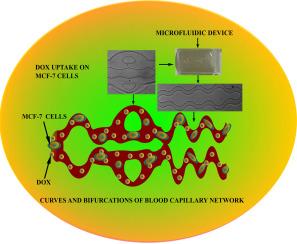An advanced microfluidic platform for assessment of DOX uptake by MCF-7 cells inside microenvironment mimicking blood capillary networks
IF 4.9
3区 工程技术
Q2 ENGINEERING, ELECTRICAL & ELECTRONIC
引用次数: 0
Abstract
Estimating drug uptake by cells in vitro is widely determined in a static environment or centrifuge. Such an uptake study cannot give a correct estimation of drug uptake on cells as drug uptake by cells happens when both drug and cells are in movement. Considering these two aspects, microchannels with two different configurations were fabricated to replicate the confinement of the blood capillary network. Channel A was designed to replicate the bifurcations of blood capillaries, while Channel B was designed to replicate its curves. The microchannels were fabricated to decipher the drug uptake on breast cancer cells (MCF-7 cells) when they flow through conditions similar to the blood capillary network. The drug uptake in Channel A and Channel B was observed to be 1.17 and 1.78 times higher than the conventional method. The inflection region where channel curvature changed caused MCF-7 cells to deform, resulting in an alteration of cytoskeleton morphology, thus allowing a better drug uptake by cells. Furthermore, the hydrodynamic effect on cell movement inside the microchannel was also investigated. It was observed that the MCF-7 cells showed noticeable deformation at the entry of the bifurcations and the inflection region. The MCF-7 cells also exhibited faster stress relaxation in the region of higher stresses. The cells’ fore tip and tail end were observed to move at different speeds during stress relaxation. The novel microfluidic channel discussed in the study provided a new and efficient platform for the complete assessment of cellular uptake of drugs.

一个先进的微流控平台,用于评估微环境中模拟毛细血管网络的MCF-7细胞对DOX的摄取
估计体外细胞的药物摄取通常是在静态环境或离心机中确定的。这种摄取研究不能正确估计细胞对药物的摄取,因为细胞对药物的摄取是在药物和细胞都在运动的情况下发生的。考虑到这两个方面,我们制作了两种不同结构的微通道来复制毛细血管网络的限制。通道A被设计用来复制毛细血管的分叉,而通道B被设计用来复制毛细血管的曲线。当乳腺癌细胞(MCF-7细胞)在类似于毛细血管网络的条件下流动时,制造微通道来破译药物对乳腺癌细胞(MCF-7细胞)的摄取。A、B通道的药物摄取分别是常规方法的1.17、1.78倍。通道曲率改变的弯曲区导致MCF-7细胞变形,导致细胞骨架形态改变,从而使细胞更好地吸收药物。此外,还研究了微通道内流体动力对细胞运动的影响。观察到MCF-7细胞在分叉入口和弯曲区有明显的变形。MCF-7细胞在高应力区域也表现出更快的应力松弛。在应力松弛过程中,观察到细胞的前端和尾部以不同的速度移动。本研究讨论的新型微流控通道为全面评估细胞对药物的摄取提供了一个新的、有效的平台。
本文章由计算机程序翻译,如有差异,请以英文原文为准。
求助全文
约1分钟内获得全文
求助全文
来源期刊

Sensors and Actuators A-physical
工程技术-工程:电子与电气
CiteScore
8.10
自引率
6.50%
发文量
630
审稿时长
49 days
期刊介绍:
Sensors and Actuators A: Physical brings together multidisciplinary interests in one journal entirely devoted to disseminating information on all aspects of research and development of solid-state devices for transducing physical signals. Sensors and Actuators A: Physical regularly publishes original papers, letters to the Editors and from time to time invited review articles within the following device areas:
• Fundamentals and Physics, such as: classification of effects, physical effects, measurement theory, modelling of sensors, measurement standards, measurement errors, units and constants, time and frequency measurement. Modeling papers should bring new modeling techniques to the field and be supported by experimental results.
• Materials and their Processing, such as: piezoelectric materials, polymers, metal oxides, III-V and II-VI semiconductors, thick and thin films, optical glass fibres, amorphous, polycrystalline and monocrystalline silicon.
• Optoelectronic sensors, such as: photovoltaic diodes, photoconductors, photodiodes, phototransistors, positron-sensitive photodetectors, optoisolators, photodiode arrays, charge-coupled devices, light-emitting diodes, injection lasers and liquid-crystal displays.
• Mechanical sensors, such as: metallic, thin-film and semiconductor strain gauges, diffused silicon pressure sensors, silicon accelerometers, solid-state displacement transducers, piezo junction devices, piezoelectric field-effect transducers (PiFETs), tunnel-diode strain sensors, surface acoustic wave devices, silicon micromechanical switches, solid-state flow meters and electronic flow controllers.
Etc...
 求助内容:
求助内容: 应助结果提醒方式:
应助结果提醒方式:


